One of our terrific summer interns, Rick Williamson, just sent a link to this 1976 TV interview of Marshall McLuhan in which he skewers the presidential debates for being completely the wrong form for the medium of television. It’s interesting to note that it’s hard to imagine an interview like on the Today show of 2008. It goes on for ten uninterrupted minutes; there are no cut-aways to video footage or text crawls at the bottom of the screen; and most significantly McLuhan speaks his mind, critical of the mechanisms of political discourse to an extent unimaginable in today’s sanitized mass media landscape.
Category Archives: mcluhan
kerfluffle at britannica.com
I got a note from someone at Britannica online telling me about a discussion prompted by Clay Shirky’s riposte to Nicolas Carr’s Atlantic article, “Is Google Making Us Stupid?”
The conversation on the Britannica site, and the related posts on John Brockman’s EDGE, remind me as much as anything of the conversational swordplay typical of TV pundits, who are so enamored of their own words that they can barely be bothered to listen to or read each other’s ideas, much less respond sincerely.
(Can it possibly be a coincidence that all the players in this drama are male? Get a grip guys! This is not about scoring points. You’re dealing with issues central to the future of the species and the planet.)
And as long as we’re dealing with missing persons, i was stunned to realize that not one of these media gurus references McLuhan, who as far as i’m concerned, not only asked more profound questions about the effect of media on humans and their society, but provided first-pass answers which we would still do well to heed.
Of the myriad posts and pages that now comprise the Britannica Carr/Shirky discussion, three posts are particular interest.
The first is from the critic Sven Birkerts, whom many people consider conservative. I don’t. Rather, I see Birkerts as the most eloquent voice on behalf of what we are losing as we shed the culture of the Gutenberg age. Birkerts doesn’t entreat us to stop time or throw wrenches in the wheels of change. He’s just asking us to be conscious of what’s good about the present.
Another is from George Dyson who writes in a way that in my worst nightmares i fear is prescient:
Nicholas Carr asks a question that all of us should be asking ourselves:
“What if the cost of machines that think is people who don’t?”
It’s a risk. “The ancestors of oysters and barnacles had heads. Snakes have lost their limbs and ostriches and penguins their power of flight. Man may just as easily lose his intelligence,” warned J. B. S. Haldane in 1928.
The third is a comment by Blair Boland, which appears as a comment to Nicolas Carr’s response to Shirky. Not only does Boland provide a taut history lesson, setting the record straight on the Luddites, but he states a fundamental issue of our time more clearly than anyone else: “who controls technology and for what ends?”
What both critiques share in common and take for granted is a smugly false and typically misleading disparagement of so-called Luddism. The original, much maligned Luddites are commonly dismissed as cranks, or worse still, “murderous thugs” and the “essential fact” of Luddite “complaint” twisted to serve the ends of propagandists for capital. Ned Ludd and his followers were not necessarily opposed to technological ‘change’ or ‘progress’ per se but the social context in which it occurred and the economic consequences it presaged. As Ludd expressed it, “we will never lay down our arms…[’til]the House of Commons passes an act to put down all machinery Hurtful to Commonality”. They realized that these changes were being undertaken undemocratically for the benefit of a narrow class of economic elites. Luddite anxieties were well founded as was their understanding of the implications for the working class in general, even though they couldn’t have foreseen all of the consequences fully. Their protests and resistance was met with the most aggressive and “murderous” suppression by the British government of the day. Thousands of troops were dispatched to put down the rebellion, not only succeeding in ruthlessly exterminating the Luddite uprising but also serving notice to workers in general of the close bonds between the state and industrialists; and the means that could be employed to discipline intractable workers. The dire conditions of the working class in the new “industrial age’ that ensued proved Luddite premonitions largely prophetic. These conditions still exist in many parts of the world. So while it’s fine to fret over the impact of the net on the reading habits of the affluent, the concerns of the Luddites still haven’t gone away. The important principle then as now, is who controls technology and for what ends? Taylor’s time/motion practices further tightened the hold of the owners of production technology over the wage serfs operating that technology, again in a very undemocratic and restrictive way, “hurtful to commonality”. These, as noted, are the same principles that guide much technological development today and are among the most worrisome aspects of its ultimate applications. “And now we’re facing a similar challenge”, to see that the latent democratizing abundance of the net is not “shaped” into the greatest expansion of social control and commercial concentration of power the world has ever known.
atomisation, part two
In the last few weeks a number of people have sent me a link to Michael Wesch’s video meditation on the evolution of media and its likely impact on all aspects of human interaction. One of Wesch’s main points is that the development of XML enables the separation of form from content which in turn is fueling the transition to new modes of communication.
Paradoxically Wesch’s video works precisely because of the integration of form and content . . . possibly one of the best uses of animated text and moving images in the service of a new kind of expository essay. If you simply read the text in an RSS reader it wouldn’t have anywhere near the impact it does. Although Wesch’s essay depends on the unity of form and content, he is certainly right about the increasing trend on the web to decontextualize content by making it independent of form. If Mcluhan was right about the medium being a crucial part of the message, then, if we are looking at content in different forms are we getting the same message? If not, what does this mean for social discourse going forward?
a dictionary in transition

James Gleick had a fascinating piece in the Times Sunday magazine on how the Oxford English Dictionary is reinventing itself in the digital age. The O.E.D. has always had to keep up with a rapidly evolving English language. It took over 60 years and two major supplements to arrive at a second edition in 1989, around the same time Tim Berners-Lee and others at the CERN particle physics lab in Switzerland were creating up with the world wide web. Ever since then, the O.E.D. been hard at work on a third edition but under radically different conditions. Now not only the language but the forms in which the language is transmitted are in an extreme state of flux:
In its early days, the O.E.D. found words almost exclusively in books; it was a record of the formal written language. No longer. The language upon which the lexicographers eavesdrop is larger, wilder and more amorphous; it is a great, swirling, expanding cloud of messaging and speech: newspapers, magazines, pamphlets; menus and business memos; Internet news groups and chat-room conversations; and television and radio broadcasts.
Crucial to this massive language research program is a vast alphabet soup known as the Oxford English Corpus, a growing database of more than a billion words, culled mostly from the web, which O.E.D. lexicographers analyze through various programs that compare and contrast contemporary word usages in contexts ranging from novels and academic papers to teen chat rooms and fan sites. Together this data comprises what the O.E.D. calls “the fullest, most accurate picture of the language today” (I’m curious to know how broadly they survey the world’s general adoption of English. I’m under the impression that it’s still largely an Anglo-American affair).
Marshall McLuhan famously summarized the shift from oral tradition to the written word as “an eye for an ear”: a general migration of thought and expression away from the folkloric soundscapes of tribal society toward encounters by individuals with visual symbols on a page, a movement that climaxed in the age of print, and which McLuhan saw at last reversed in the global village of electronic mass media. The curious thing that McLuhan did not live long enough to witness was the fusion of eye-ear cultures in the fast-moving textual traditions of cell phones and the Internet. Written language has acquired an immediacy and a malleability almost matching oral speech, and the effect is a disorienting blurring of boundaries where writing is almost the same as speaking, reading more like overhearing.
So what is a dictionary to do? Or be? Such fundamental change in the process of maintaining “the definitive record of the English language” must have an effect on the product. Might the third “edition” be its final never-ending one? Gleick again:
No one can say for sure whether O.E.D.3 will ever be published in paper and ink. By the point of decision, not before 20 years or so, it will have doubled in size yet again. In the meantime, it is materializing before the world’s eyes, bit by bit, online. It is a thoroughgoing revision of the entire text. Whereas the second edition just added new words and new usages to the original entries, the current project is researching and revising from scratch — preserving the history but aiming at a more coherent whole.
They’ve even experimented with bringing readers into the process, working with the BBC earlier this year to solicit public aid in locating first usages for a list of particularly hard-to-trace words. One wonders how far they’d go in this direction. It’s one thing to let people contribute at the edges — the 50 words in that list are all from the 20th century — but to open the full source code is quite another. It seems the dictionary’s challenge is to remain a sturdy ark for the English language during this period of flood, and to proceed under the assumption that we may have seen the last of the land.
(image by Kenneth Moyle)
an open letter to claire israel

backwards into the future
Reading Christine Boese’s anticipatory critique of the new NY Times Reader, I was reminded of something I saw last winter in Seoul at Chosun Ilbo, which is pretty much the Korean equivalent of The New York Times. Off the main lobby, the newspaper has set up an exhibition space called the “Media Lab,” where the latest prototypes from the paper’s digital technology wing are on public display. A sneak peak at the future of news.
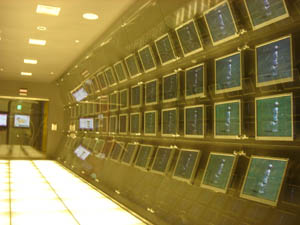
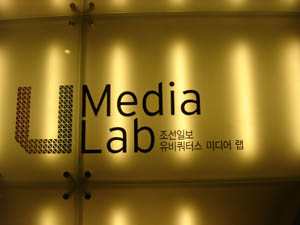
While there, I taped a demo that shows a new reading interface they’ve developed called “T-Paper,” which was supposedly slated for release this year (though I haven’t heard anything about it since). Strolling through the gallery, I found it running across a range of devices, from large flat-screen televisions to laptops, to Sony PSPs, to tiny pocket assistants. Here’s the wall display:
My first reaction was much like Chris’s: “a ‘horseless carriage’ retrenchment” — porting the artifact of the broadsheet newspaper into a digital environment. I have to admit, though, that I was slightly seduced by the zoom interface, which reminded me of this proof of a similar concept by the late interface pioneer Jef Raskin. It’s especially impressive to see it done with video. Though the Times Reader doesn’t sport anything as fancy as this, a commenter named Kevin (who I can only assume works for the Times — or Microsoft) insists that it will have much of the reader-driven functionality we would hope for (including the ability to share comments and annotations with other readers), in spite of the fact that it will be, as Chris puts it, “a walled garden.”
Kevin also refers to usability studies that suggest the Times Reader helps users “retain more information and read for longer periods.” I’ll buy longer periods — I always read more of the paper when I have it in print, and this new device certainly replicates much of the experience of print reading, while incorporating some nice new features. But still, are these proprietary, bound devices really going to replace newspapers? It seems doubtful when news consumption is such a multi-sourced affair these days (though to some extent that’s an illusion). A device that allows readers to design their news menu seems more the ticket. Maybe the Times should be thinking more in terms of branded software than proprietary hardware. Make the best news reader on the web, prominently featuring Times content, but allowing users to customize their reading experience. Keep it open and plugged in. Let the Times be your gateway to more than just the Times.
Chosun Ilbo’s vision seemed similarly constrained. As much as they tried to create a futuristic atmosphere with their Media Lab, much of the technology on display seemed, like the Times Reader, to be stuck in old mindsets — fixated more on the digital apotheosis of their product than on really grappling with the realities of the new media environment.  T-Paper also reminded of another museum piece, the British Museum’s “Turning the Pages,” which remounts famous old manuscripts like DaVinci’s journals in a fancy page-turning interface. A while back, Sally Northmore wrote a nice piece for if:book pondering this strange print-digital artifact, and what it means to electronically replicate the turning of a page. All of this recalls Marshall McLuhan’s famous observation in The Medium is the Massage:
T-Paper also reminded of another museum piece, the British Museum’s “Turning the Pages,” which remounts famous old manuscripts like DaVinci’s journals in a fancy page-turning interface. A while back, Sally Northmore wrote a nice piece for if:book pondering this strange print-digital artifact, and what it means to electronically replicate the turning of a page. All of this recalls Marshall McLuhan’s famous observation in The Medium is the Massage:
“When faced with a totally new situation, we tend always to attach ourselves to the objects, to the flavor of the most recent past. We look at the present through a rear-view mirror. We march backwards into the future…”
Much of the disoreintation I felt while in Korea came from this feeling of time pulling in different directions. A society saturated in technology, far more wired than ours, Korea rushes headlong into the future, yet at the same time digs its heels obstinately into the past. At the end of the Korean War, Seoul was a bombed-out pit of some half million people. Now it’s a sprawling megalopolis of over 20 million, and though many centuries-old, it feels streamlined and new. There’s no “old city” in any real sense. Shiny glass towers and enormous shopping centers loom over the streets, pedestrian shopping lanes explode into jungles of neon, tiny alleys teem with life like fissures in a coral reef, and a vast network of subways rumbles beneath. And yet this dynamic scene — the swirl of steaming tripe vendors and blinking electronics — is periodically interrupted by a medieval gate or pagoda, a historic remainder sitting tranquilly amid the churn of modern life.

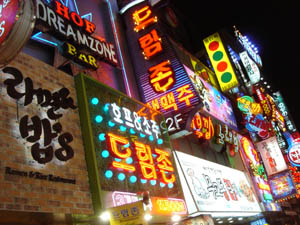
Spend an afternoon walking through Seoul and you’ll see the full pageant of the local techno-culture. Cell phones are clearly several generations further evolved than anything we have here in the States. People seem to be doing just about everything with their mobile devices: playing games, watching TV, surfing the web. I even saw one woman on a train using her phone’s video camera as a pocket mirror to fix her make-up. Young men spend hours tucked away in smoky, windowless internet cafes known as “PC Bangs,” playing multi-player online games that involve a quarter of the citizenry. At the same time, you are frequently reminded of Korea’s abiding infatuation with printing, paper crafts and calligraphy: stores sumptuously arrayed with handmade paper hung on racks, prodigiously plumed ink brushes hanging like icicles from the ceiling, and delicate little rice paper journals piled neatly on the shelves.

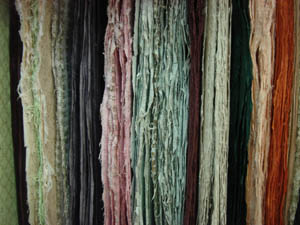
Mountains also serve to anchor swift-moving Seoul in time. 70 percent of the Korean peninsula is mountainous and the Seoul region is no exception. Sitting in the heart of downtown is the petite Namsan peak, surrounded by one of the city’s best-loved parks and sporting at its summit Seoul’s most recognizable landmark, Seoul Tower, a rocket ship awaiting blastoff. Facing Namsan, the snow-streaked Bugaksan peak rises over one of Seoul’s central boulevards, an avenue running through what feels like the Korean equivalent of Rockefeller Plaza, past City Hall, the big newspaper offices, the Ubiquitous Dream Hall and the Ministry of Reunification, leading to the Gyeongbok Palace, and beyond that the Presidential “Blue House,” nestled in Bugaksan’s shade.


Framed by the mountain, presiding over the unending traffic of Hyundais, Kias, Daewoos, and Samsungs, is an imposing statue of Admiral Yi, the famous military leader who in the late 16th century dealt a humiliating blow to the Japanese navy with the most advanced technology of his time: a fleet of armor-plated, smoke-breathing “turtle boats.”
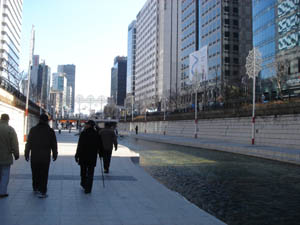
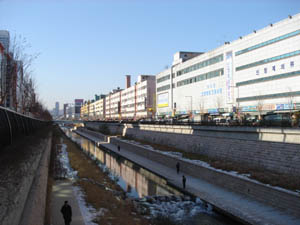
Much of Seoul’s past lies beneath the modern streets, and occasionally something is unearthed and restored (or reinvented). Announced by a waterfall perpendicular to the grand boulevard is the Cheonggyecheon, an ancient stream running through the heart of the city into the countryside beyond, and which until very recently was covered over by an elevated highway. Last year, the city demolished the roadway, uncovered the stream and built a lovely sunken path alongside it cutting quietly through six miles of the city’s bustle. If you’ve ever been to Paris and walked directly along the Seine on the lower walkways, you can sort of picture this, though the Cheonggyecheon is no Seine — a small stream and a fairly narrow trench. But walking there, with the tops of buildings peeking over, an improbable calm steals over you in the heart of town.
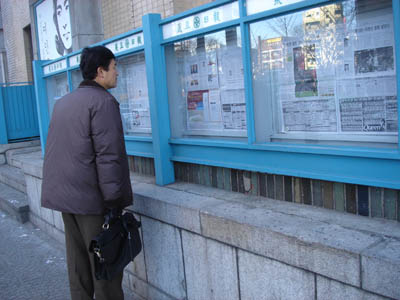

And because this reminiscence began with newspapers, take a look at these pictures. A few blocks from the waterfalls that reintroduce the Cheonggyecheon to the city after all these years, the very same newspapers that pride themselves on publishing at the cutting edge of technology still mount their daily editions, page by page, in glass cases on the street for all to read.
questions on libraries, books and more
Last week, Vince Mallardi contacted me to get some commentary for a program he is developing for the Library Binding Institute in May. I suggested that he send me some questions, and I would take a pass at them, and post them on the blog. My hope that is, Vince, as well as our colleagues and readers will comment upon my admittedly rough thoughts I have sketched out, in response to his rather interesting questions.
1. What is your vision of the library of the future if there will be libraries?
Needless to say, I love libraries, and have been an avid user of both academic and public libraries since the time I could read. Libraries will be in existence for a long time. If one looks at the various missions of a library, including the archiving, categorization, and sharing of information, these themes will only be more relevant in the digital age for both print and digital text. There is text whose meaning is fundamentally tied to its medium. Therefore, the creation and thus preservation of physical books (and not just its digitization) is still important. Of course, libraries will look and function in a very different way from how we conceptualize libraries today.
As much as, I love walking through library stacks, I realize that it is a luxury of the North, which was made more clear to me at the recent Access to Knowledge conference my colleague and I were fortunate enough to attend. In the economic global divide of the North and South, the importance of access to knowledge supersedes my affinity for paper books. I realize that in the South, digital libraries are a much efficient use of resources to promote sustainable knowledge, and hopefully economic, growth.
2. How much will self-publishing benefit book manufacturers, indeed save them?
Recently, I have been very intrigued with the notion of Print On Demand (POD) of books. My hope is that the stigma will be removed from the so-called “vanity press.” Start-up ventures, such as LuLu.com, have the potential to allow voices to flourish, where in the past they lacked access to traditional book publishing and manufacturing.
Looking at the often cited observation that 57% of Amazon book sales comes from books in the Long Tail (here defined as the catalogue not typically available in the 100,000 books found in a B&N superstore,) I wonder if the same economic effect could be reaped in the publishing side of books. Increasing efficiency of digital production, communication, and storage, relieve economic pressures of the small run printing of books. With print on demand, costs such as maintaining inventory are removed, as well, the risk involved in estimating the demand for first runs is reduced. Similarly, as I stated in my first response, the landscape of book manufacturing will have to adapt as well. However, I do see potential for the creation of more books rather than less.
3. What co-existence do you foresee between the printed and electronic book, as co-packaged, interactive via barcodes or steganography? etc.
Paper based books will still have its role in communication in the future. Paper is still a great technology for communication. For centuries, paper and books were the dominate medium because that was the best technology available. However, with film, television, radio and now digital forms, it is not longer always true. Thus the use of print text must be based upon the decision by the author that paper is the best medium for her creative purposes. Moving books into the digital allows for forms that cannot exist as a paper book, for instance the inclusion of audio and video. I can easily see a time when an extended analysis of a Hitchcock movie will be an annotated movie, with voice over commentary, text annotation and visual overlays. These features cannot be reproduced in traditional paper books.
Rather, that try to predict specific applications, products or outcomes, I would prefer to open the discussion to a question of form. There is fertile ground to explore the relationship between paper and digital books, however it is too early for me to state exactly what that will entail. I look forward to seeing what creative interplay of print text and digital text authors will produce in the future. The co-existence between the print and electronic book in a co-packaged form will only be useful and relevant, if the author consciously writes and designs her work to require both forms. Creating a pdf of Proust’s Swann Way’s is not going to replace the print version. Likewise, printing out Moulthrop’s Victory Garden do not make sense either.
4. Can there be literacy without print? To the McLuhan Gutenberg Galaxy proposition.
Print will not fade out of existence, so the question is a theoretical one. Although, I’m not an expert in McLuhan, I feel that literacy will still be as vital in the digital age as it is today, if not more so. The difference between the pre-movable type age and the electronic age, is that we will still have the advantages of mass reproduction and storage that people did not have in an oral culture. In fact, because the marginal cost of digital reproduction is basically zero, the amount of information we will be subjected to will only increase. This massive amount of information which we will need to process and understand will only heighten the need for not only literacy, but media literacy as well.
two newspapers
 I picked up The New York Times from outside my door this morning knowing that the lead headline was going to be wrong. I still read the print paper every morning – I do read the electronic version, but I find that my reading there tends to be more self-selecting than I’d like it to be – but lately I find myself checking the Web before settling down to the paper and a cup of coffee. On the Web, I’d already seen the predictable gloating and hand-wringing in evidence there. Because of some communication mixup, the papers went to press with the information that the trapped West Virginia coal miners were mostly alive; a few hours later it turned out that they were, in fact, mostly dead. A scrutiny of the front pages of the New York dailies at the bodega this morning revealed that just about all had the wrong news – only Hoy, a Spanish-language daily didn’t have the story, presumably because it went to press a bit earlier. At right is the front page of today’s USA Today, the nation’s most popular newspaper; click on the thumbnail for a more legible version. See also the gallery at their “newseum”. (Note that this link won’t show today’s papers tomorrow – my apologies, readers of the future, there doesn’t seem to be anything that can be done for you, copyright and all that.)
I picked up The New York Times from outside my door this morning knowing that the lead headline was going to be wrong. I still read the print paper every morning – I do read the electronic version, but I find that my reading there tends to be more self-selecting than I’d like it to be – but lately I find myself checking the Web before settling down to the paper and a cup of coffee. On the Web, I’d already seen the predictable gloating and hand-wringing in evidence there. Because of some communication mixup, the papers went to press with the information that the trapped West Virginia coal miners were mostly alive; a few hours later it turned out that they were, in fact, mostly dead. A scrutiny of the front pages of the New York dailies at the bodega this morning revealed that just about all had the wrong news – only Hoy, a Spanish-language daily didn’t have the story, presumably because it went to press a bit earlier. At right is the front page of today’s USA Today, the nation’s most popular newspaper; click on the thumbnail for a more legible version. See also the gallery at their “newseum”. (Note that this link won’t show today’s papers tomorrow – my apologies, readers of the future, there doesn’t seem to be anything that can be done for you, copyright and all that.)
 At left is another front page of a newspaper, The New York Times from April 20, 1950 (again, click to see a legible version). I found it last night at the start of Marshall McLuhan’s The Mechanical Bride: Folklore of Industrial Man. Published in 1951, The Mechanical Bride is one of McLuhan’s earliest works; in it, he primarily looks at the then-current world of print advertising, starting with the front page shown here. To my jaundiced eye, most of the book hasn’t stood up that well; while it was undoubtedly very interesting at the time – being one of the first attempts to seriously deal with how people interact with advertisements from a critical perspective – fifty years, and billions and billions of advertisements later, it doesn’t stand up as well as, say, Judith Williamson‘s Decoding Advertisements manages to. But bits of it are still interesting: McLuhan presents this front page to talk about how Stephane Mallarmé and the Symbolists found the newspaper to be the modern symbol of their day, with the different stories all jostling each other for prominence on the page.
At left is another front page of a newspaper, The New York Times from April 20, 1950 (again, click to see a legible version). I found it last night at the start of Marshall McLuhan’s The Mechanical Bride: Folklore of Industrial Man. Published in 1951, The Mechanical Bride is one of McLuhan’s earliest works; in it, he primarily looks at the then-current world of print advertising, starting with the front page shown here. To my jaundiced eye, most of the book hasn’t stood up that well; while it was undoubtedly very interesting at the time – being one of the first attempts to seriously deal with how people interact with advertisements from a critical perspective – fifty years, and billions and billions of advertisements later, it doesn’t stand up as well as, say, Judith Williamson‘s Decoding Advertisements manages to. But bits of it are still interesting: McLuhan presents this front page to talk about how Stephane Mallarmé and the Symbolists found the newspaper to be the modern symbol of their day, with the different stories all jostling each other for prominence on the page.
But you don’t – at least, I don’t – immediately see that when you look at the front page that McLuhan exhibits. This was presumably an extremely ordinary front page when he was exhibiting it, just as the USA Today up top might be representative today. Looked at today, though, it’s something else entirely, especially when you what newspapers look like now. You can notice this even in my thumbnails: when both papers are normalized to 200 pixels wide, you can’t read anything in the old one, besides that it says “The New York Times” as the top, whereas you can make out the headlines to four stories in the USA Today. Newspapers have changed, not just from black & white to color, but in the way the present text and images. In the old paper there are only two photos, headshots of white men in the news – one a politician who’s just given a speech, the other a doctor who’s had his license revoked. The USA Today has perhaps an analogue to that photo in Jack Abramoff’s perp walk; it also has five other photos, one of the miners’ deluded family members (along with Abramoff, the only news photos), two sports-related photos – one of which seems to be stock footage of the Rose Bowl sign, a photo advertising television coverage inside, and a photo of two students for a human interest story. This being the USA Today, there’s also a silly graph in the bottom left; the green strip across the bottom is an ad.
Photos and graphics take up more than a third of the front page of today’s paper.
What’s overwhelming to me about the old Times cover is how much text there is. This was not a newspaper that was meant to be read at a glance – as you can do with the thumbnail of the USA Today. If you look at the Times more closely it looks like everything on the front page is serious news. You could make an argument here about the decline of journalism, but I’m not that interested in that. More interesting is how visual print culture has become. Technology has enabled this – a reasonably intelligent high-schooler could, I think, create a layout like the USA Today. But having this possibility available would also seem to have had an impact on the content – and whether McLuhan would have predicted that, I can’t say.
google is sued… again
This time by publishers. Penguin Group USA, McGraw-Hill, Pearson Education, Simon & Schuster and John Wiley & Sons. The gripe is the same as with the Authors’ Guild, which filed suit last month alleging “massive copyright infringement.” Publishers fear a dangerous precedent is set by Google’s scanning of books to construct what amounts to a giant card catalogue on the web. Google claims “fair use” (see rationale), again pointing out that for copyrighted works only tiny “snippets” of text are displayed around keywords (though perhaps this is not yet fully in effect – I was searching around in this book and was able to look at quite a lot).
Google calls the publishers’ suit “near-sighted.” And it probably is. The benefit to readers and researchers will be tremendous, as will (Google is eager to point out) the exposure for authors and publishers. But Google Print is undoubtedly an earth-shaking program. Look at the reaction in Europe, where alarm bells rung by France warned of cultural imperialism, an english-drenched web. Heads of state and culture convened and initial plans for a European digital library have been drawn up.
What the transatlantic flap makes clear is that Google’s book scanning touches a deep nerve, and the argument over intellectual property, signficant though it is, distracts from a more profound human anxiety — an anxiety about the form of culture and the shape of thoughts. If we try to grope back through the millennia, we can find find an analogy in the invention of writing.
The shift from oral to written language froze speech into stable strings that could be transmitted and stored over distance and time. This change not only affected the modes of communication, it dramatically refigured the cognitive makeup of human beings (as McLuhan, Ong and others have described). We are currently going through another such shift. The digital takes the freezing medium of text and throws it back into fluidity. Like the melting of polar ice caps, it unsettles equilibriums, changes weather patterns. It is a lot to adjust to, and we wonder if our great-great-grandchildren will literally think differently from us.
But in spite of this disorienting new fluidity, we still have print, we still have the book. And actually, Google Print in many ways affirms this since its search returns will point to print retailers and brick-and-mortar libraries. Yet the fact remains that the canon is being scanned, with implications we can’t fully perceive, and future uses we can’t fully predict, and so it is understandable that many are unnerved. The ice is really beginning to melt.
In Phaedrus, Plato expresses a similar anxiety about the invention of writing. He tells the tale of Theuth, an Egyptian deity who goes around spreading the new technology, and one day encounters a skeptic in King Thamus:
…you who are the father of letters, from a paternal love of your own children have been led to attribute to them a power opposite to that which they in fact possess. For this discovery of yours will create forgetfulness in the minds of those who learn to use it; they will not exercise their memories, but, trusting in external, foreign marks, they will not bring things to remembrance from within themselves. You have discovered a remedy not for memory, but for reminding. You offer your students the appearance of wisdom, not true wisdom. They will be hearers of many things and will have learned nothing; they will appear to be omniscient and will generally know nothing; they will be tiresome company, having the show of wisdom without the reality.
As I type, I’m exhibiting wisdom without the reality. I’ve read Plato, but nowhere near exhaustively. Yet I can slash and weave texts on the web in seconds, throw together a blog entry and send it screeching into the commons. And with Google Print I can get the quote I need and let the rest of the book rot behind the security fence. This fluidity is dangerous because it makes connections so easy. Do we know what we are connecting?
